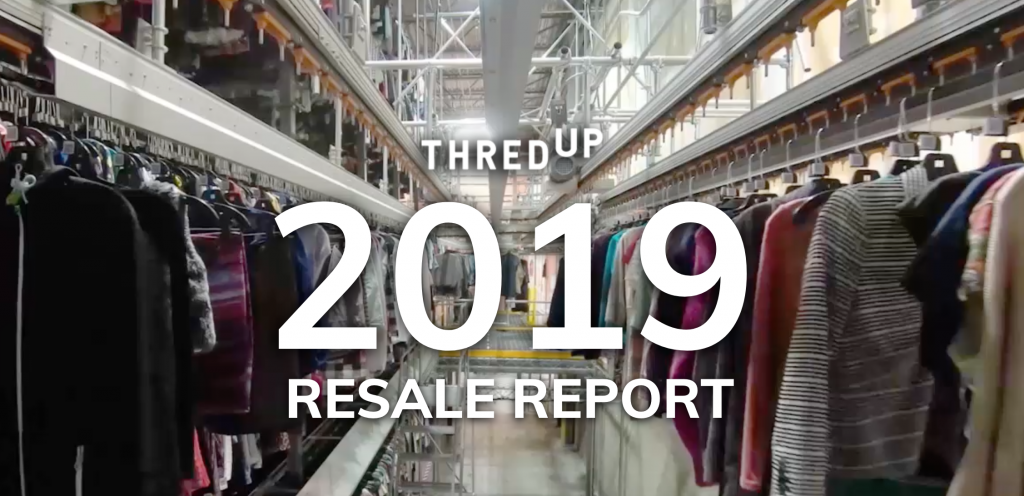Photo courtesy of Swap Society’s website.
Thrift shopping is popular with students such as Gabriella DiGiovanni, a Pepperdine sophomore. However, not only can secondhand shopping save money it can also can be an important step toward saving the environment.
“People dump all their clothes at Goodwill then shop all of their clothes at Goodwill,” DiGiovanni says. “Half my wardrobe is from Goodwill. There’s always the option to reuse which may not always be in style but it’s a way to curate your taste.”
The Problem
The 26 billion pounds of textiles that end up in a landfill each year makes the clothing industry the second-most polluting industry in the world after oil, according to the Savers State of Refuse 2017 report.
“The world now consumes more than 80 billion pieces of new clothing every year, with Americans alone buying four times as much clothing as they did in 1980,” as stated by the Savers State of Reuse report. Furthermore, “only 16 percent of clothing and textiles are recycled, or as defined by the EPA, collected, processed and turned into new products as materials that would otherwise be thrown away as trash and turning them into new products.”
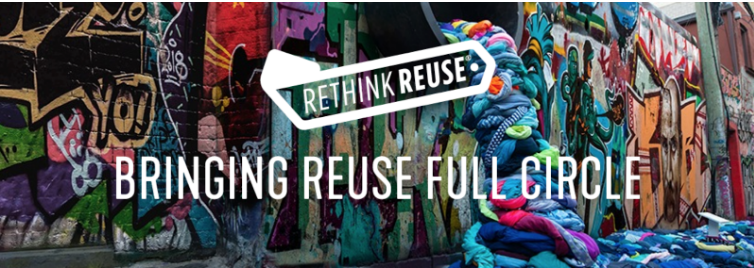
Photo courtesy of Savers.com
Lastly, despite the number of clothes purchased and/or donated, the report found that 46 percent of North Americans say they have ‘‘way too much stuff,” and they still seem to want more.
It is expected that there will be about 5.4 billion people in the global middle class by 2030, and that there will be an additional increase in the demand for clothes that will come to define middle-income lifestyles, according to the World Resources Institute 2017 report. If the current rate of consumption continues, WRI expects that the world will need three times the natural resources by 2050 to accommodate these demands.
Pepperdine Sustainability Prof. Christopher Doran said one of the problems with these demands is that society is already running out of resources due to the damage that has already been done to the planet.
“The production of these things causes a lot of CO2 to go into the air from the electricity that is used to the burning of materials,” Doran said. “Water waste is a big deal because you need a lot of water to create these materials or to process these materials. If that water is not treated well then it is discharged into the drinking water supplies.”
It takes approximately 1,200 liters of water to produce one cotton shirt, according to The World Resources Institute. Furthermore, about 20 percent of industrial water pollution is caused by garment manufacturing as the clothing industry uses 5 trillion liters (1.3 trillion gallons) of water each year for fabric dyeing, which is the equivalent to 2 million Olympic-sized swimming pools.
The damage does not stop in the ocean. It also extends itself beyond the shore and into the atmosphere.
Global apparel and footwear industries account for 8% of the world’s greenhouse gas emissions due to the four metric gigatonnes of CO2 that their efforts release into the atmosphere, according to a 2018 Quantis research study.
Lastly, over 50% of emissions from the production of clothing comes from three phases: dyeing and finishing (36%), yarn preparation (28%) and fiber production (15%), according to the Quantis 2018 report. The report also found that dyeing and finishing and yarn preparation is said to have the largest impact on freshwater withdrawal and the ecosystem due to their high dependency on fossil-based energy and the energy intensive processing that goes into both phases’ production processes.
“There is a lot of ignorance, and that ignorance is intentionally created on the part of textile manufacturing and other global corporations that don’t want consumers to know the supply chain,” Doran said.
So can a stylish society also be sustainable?
Millennials and Generation Z Lead the Way
Fast fashion trends may be targeting a younger consumer market, but major retailers’ efforts are now falling short as millennials and generation Z are driving secondhand shopping.
Millennials and Generation Z are the largest leaders in the sustainability movement, according to the thredUP 2019 Resale Report. ThredUP is a popular online fashion retail company. In addition, 74 percent of 18 to 29 year olds prefer to purchase from “sustainably conscious brands” and 18 to 37 year olds are 2.5 times more likely to purchase second-hand clothing, as compared to other generations, according to the report.
Image courtesy of thredUP.com
Statistics show that millennials and generation Z consumers, such as DiGiovanni, are leading the way toward a zero-waste and sustainable society, but how do they plan to pursue this goal? From college clothing swaps, secondhand shopping sites, and education beyond the classroom, this generation of consumers is making fast fashion run out of style.
The Swap Society solution
One sustainable effort that seems to be making headway are clothing swaps. Clothing swaps, although differ among various organizations, typically involve individuals exchanging their already-purchased (and now unwanted) clothes for either new garments, a new wardrobe, or sometimes monetary incentives.
One of the most well-known clothing swap organizations is Swap Society. From its online community, to in-person events, Swap Society is leading the way in small town and big city communities, in effort to create a world where style and sustainability can co-exist. So how did the swap get started?
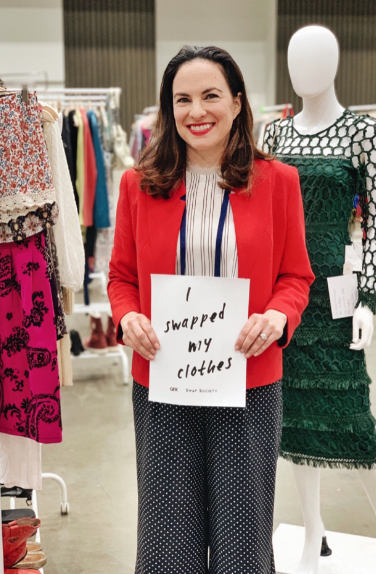
Photo courtesy of Mochni. Nicole Robertson, Swap Society co-founder and CEO, at ReMode.
Swap Society’s co-founder and CEO, Nicole Robertson, said she has always been an environmentalist, or so she thought. Despite engaging in practical sustainable fashion practices like selling her old clothes at the thrift store, or giving away hand-me-downs to friends, Robertson said it was not until she had the opportunity to work for a bio-manufacturing company that she started to think about personal consumption and her footprint on this planet.
“It was around that time that I learned how polluting the fashion industry is and that there are so many problems with the fashion industry,” Robertson said. “Also around that time, I was super busy and I didn’t have time to sell my clothes online. And back then, there weren’t a lot of the options we have today.”
After a thorough Google search, and much to her surprise, Robertson found a clothing swap near her Los Angeles neighborhood in Playa Del Rey that encompassed a little over 100 women on the West side.
“After I found that clothing swap, I basically stopped buying new clothes and was just swapping,” Robertson said. “And I loved it.”
Robertson’s love for the company grew into her taking it over and marketing it to a larger audience online. Robertson then decided to develop her business model to address some of the issue she saw with certain thrift stores and other online resale and consignment websites.
“One thing that was important for us was making sure that people get equal value for their clothes, because if you’re doing resale, you’ll usually get about 2-4 percent back of what you paid for the garment and then the markups are usually about 10 x from there,” Robertson said. “It’s cheaper than buying new, but you’re not getting a huge percentage back of what you paid.”
ThredUP pays sellers 5 to 80 percent of the selling price and pockets the remaining 20 to 95 percent. According to their website, the more desirable the item is for the site, the higher percentage (and therefore) more money the seller makes. However, the desirability of each item depends on the judgment of thredUP style experts.
“I was also noticing that a lot of the solutions out there don’t really accommodate everyone’s budget,” Robertson said. “A lot of them focus on designer and luxury brands, which can be really cost-prohibitive to people. So we also wanted to make it {swap society} something that could be available to the masses that would be affordable for everyone.”
Swap Society uses a point system based off of desirability, seasonality, condition, inventory and retail value of each garment. This system, in turn, aims to give users back what they sent over. “So, if you only send in low point items, you will not have access to high point items,” as stated on their website. “For example, some people might only send in items from mass retailers such as the Gap (and that’s totally fine!), but a dozen Gap items will not get you a luxury brand cocktail dress unless you’re swapping in some of the fancy stuff too. We let you know what your highest range is when we send you your point total.”
Some of the items that Swap Society does not accept are swimwear, panties, hosiery, bags, and shoes. They also encourage potential sellers to make sure the clothes don’t have tears, stains, rips, and/or alterations.
Robertson advises potential customers not to worry too much about the condition of their garments because if the clothes are not expected, they are still able live on after swap.
“Unaccepted items are upcycled by sustainable fashion brands MeWe Clothing and ELLERALI or donated to charity, including Downtown Women’s Center (DWC). DWC is the only organization in Los Angeles focused exclusively on serving and empowering women experiencing homelessness and formerly homeless women,” according to the Swap Society’s website.
“The reality is that we have a very narrow window of time to make a significant impact,” Robertson said. “And so, fashion is just a tiny piece of that puzzle, but I think that it’s a way that we can communicate the story and empower individuals to make changes in their own lives that can also help spark the conversation in other areas as well.”
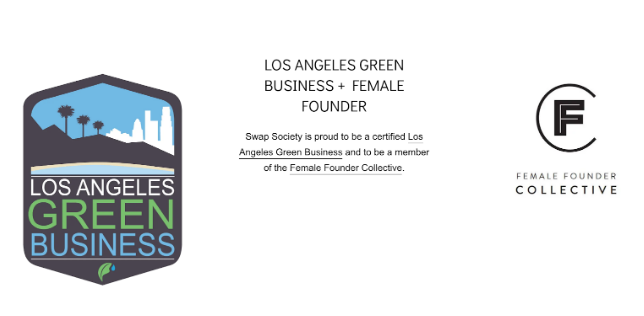
Photo taken from Swap Society’s website.
Robertson said that she is excited to be part of solution that caters to people who are buying fast fashion, and show them an alternative way of shopping that is also sustainable.
“I’m so excited to be part of a solution that is different and unique, and that can cater to people that are buying fast fashion,” Robertson said. “And I think that younger people are really steering this direction to a more sustainable wardrobe and I think that’s even more exciting to see.”
There are more secondhand shoppers today than ever before with 64 percent of women over the age of 18 are now willing to buy secondhand clothing, according to the report by thredUP. And this number is expected to follow an increasing pattern, as 56 million women are said to have bought second-hand products in 2018, which is up from the 44 million women who purchase second-hand products in 2017.
College Campus Efforts
With Millennials and Generation Z driving the secondhand shopping market, college campuses have become a platform for igniting and initiating the pursuit of sustainable living among the millennial generation.
“On a college campus, there is so much opportunity to educate the student about sustainability,” according to Pepperdine’s Director of the Center for Sustainability, Camila Pupparo. “At Pepperdine, we try to do it in a way that is not just teaching students to be sustainable while at Pepperdine. It’s for when you go on to live your life after pepperdine, to carry it with you.”
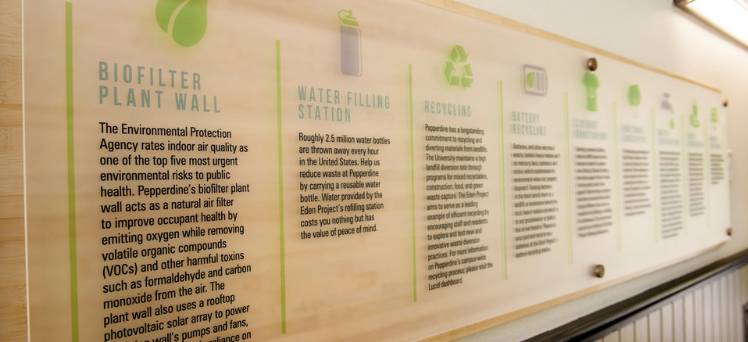
Photo taken from the Pepperdine Center for Sustainability website.
In addition to offering a minor in Sustainability, Pepperdine also offers a variety of classes that fulfill the university’s GE requirement, such as REL 301, Sustainability and Christianity and SUST 592 Selected Topics in Sustainability (1-4).
After taking REL 301 Sustainability and Christianity, Pepperdine senior Jessica Remlinger was shocked by the statistics of the fashion industry’s waste and decided to take matters into her own by starting a club convocation dedicated to educating her peers about the harmful effects of fast fashion.
“We are the ones who care the most about our clothing, but we also are the ones who don’t have enough money to spend on nice clothing, so we are forced to participate in fast-fashion,” Remlinger said. “So I wanted to create a place where people became aware that there are alternative shopping options like thrift stores or shopping at environmentally friendly brands because it’s not too difficult.”
Pupparo said that convenience has a major impact on sustainable living efforts.
“But, as we all know, being sustainable is worth it,” Pupparo said. “It takes a little bit of effort.”
Campus clubs such as The Pepperdine Sustainability Club, said they appreciated being able to use the sustainability center as a resource for creating new initiatives and social media campaigns to alert the student body of the harmful effects of textile waste.
“Everyone on this campus wants a clean living environment,” said the Sustainability Club’s team leader Hunter Leppard. “No one is actively saying let’s go out and destroy this campus, but it’s the awareness and education that we need to recycle and reduce waste that no one is really thinking twice about before they throw things away. So our goal is to be that extra step of education.”
The main goal of Pepperdine’s sustainability club is reducing the amount of textile waste during campus check-out season. Because the check-out process seems to spring upon students so quickly after finals, the sustainability club said that many clothes, bedding, and plastic bins are left in the dumpster when they could be put in the Salvation Army bins or recycled.
“Administration has acknowledged that it is a problem, but I wouldn’t put too much blame on them,” said sustainability club member, Ben Slattery. “Ultimately, it’s on us as residents and students…It’s our responsibility at some point because they {Pepperdine} give us the resources, it’s just people need to know how to take advantage of it.”
Pupparo said the university’s commitment to sustainable living is not only prevalent in the center. It can also be seen in the academic division, where the new sustainability minor was created in light of the university’s passion for an environmentally friendly future.
“A lot of schools say they are all about sustainability, but when it comes down to doing something, like creating a minor to educate the student body, that doesn’t always happen,” Pupparo said. “It shows the openness the faculty, the administration, the fact that they care and they want to see more progress in that area.”
The Influence of E-commerce
Millennials are the driving force of environmental change for fashion, and companies are catching up. Many companies are making strides to reduce their environmental footprint.
While thrift stores like Goodwill have been around for years, online thrift stores have come into the making in the recent decade. The Real Real is an example of a curated thrift store that buys and sells gently used luxury items. They have a large online presence, but they also have brick and mortar stores in California, New York, Florida, Texas, and more, according to their website
Rent the Runway is another e-commerce platform that mixes the idea of fast fashion with environmental sustainability. Courtney Lyons, a social media account manager for Rent the Runway and head of Lyons Feel, explains that Rent the Runway is the “Netflix of fashion” with its subscription service.
“In order to rent you have to set up an account at Rent the Runway,” Lyons says. “Then you can either choose to purchase a subscription or a one-time rental. I use the one time-rentals when I have events like formals, and I use the subscription to replace everyday clothes that I would’ve previously bought at ZARA.”
Lyons explains how Rent the Runway is trying to tackle the fast fashion industry.
“They allow for people to continue this “disposable” behavior that they’ve grown accustomed to while still being environmentally conscious. People can buy a small selection of high-quality clothing that they love and rent everything else. You never have to commit to a trend!”
Rent the Runway is one of the leaders of the e-commerce sustainable fashion industry, all while using reusable packaging.
Bettering of Brands
A higher demand of ethically sourced fashion by consumers has directed large scale fashion companies to take greater steps in reducing their ecological footprint. The production process brings numerous issues: water pollution, natural resource destruction, greenhouse gas emissions, and general waste accumulation according to Stain Your Style. While some of these impacts will be inherent, others are preventable. Brands such as Stella McCartney, Levi Strauss & Co., and Adidas are making strides to reduce the negative environmental impacts of the fashion industry.
Stella McCartney’s eponymous designer label brand only uses vegan products. According to Good on You, Stella McCartney has numerous goals in place to substantially reduce greenhouse gas emissions and water waste by 2020. By using vegan leather, the brand’s production sequence does not include cows, so greenhouse gas emissions are substantially lower than the average company that uses leather.
Levi Strauss & Co. is famous for their denim. On World Water Day 2012, Levi’s launched their “Water<Less” initiative that reduces the amount of water through 20 key techniques. This initiative has expanded to 360 Levi’s clothing items.
“Our designers challenged themselves to get the same looks we all love, but using less water in the finishing stage,” Levi’s website states. “That’s why Levi’s® developed more than 20 innovative techniques that do just that: use less of our world’s precious natural resource.”
Not only is Levi’s changing their company internally, but they are making an attempt at redefining the industry as a whole.
Adidas takes a different approach to water. A full Adidas apparel line including shoes made with Parley ocean plastic, plastic that is intercepted from beaches before going into oceans.
“We are working with Parley to keep plastic from entering our oceans and transform it into high-performance sportswear,” according to a Adidas’ website. “Spinning the problem into a solution. The threat into a thread.”
_______________________________________
Contact Madison Nichols: madison.nichols@pepperdine.edu
Contact Tiger Ashtiani: tiger.ashtiani@pepperdine,edu

